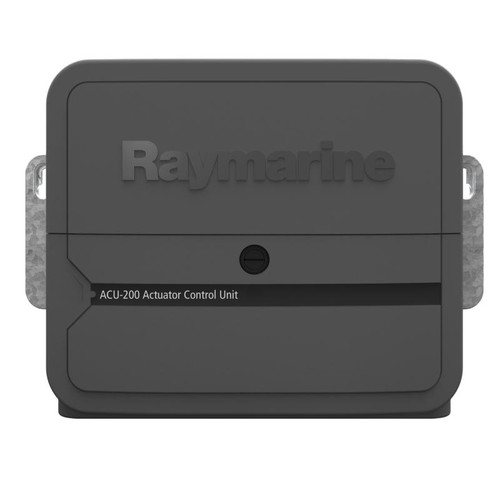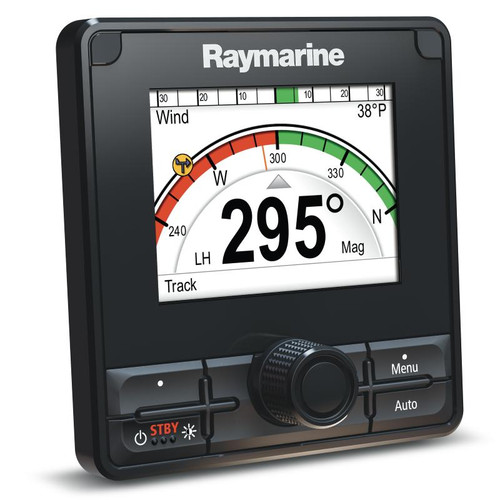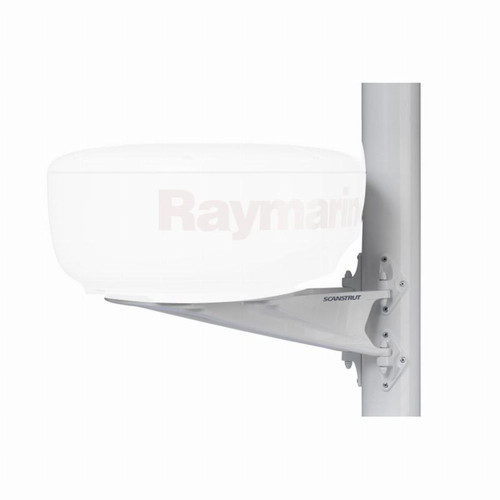-

Raymarine
Raymarine Mechanical Rotary Drive - Type 2 - Boats Up To 20 tonnes
Raymarine Mechanical Rotary Drive - Type 2 for boats up to 20 tonnes. The rotary drive is designed for power and sailboat systems that can be driven from the helm position through a chain and sprocket (e.g. cable and rod steering system). The outstanding...
-

Raymarine
Raymarine Mechanical Linear Drive Unit - Type 2 Long
Raymarine Mechanical Linear Drive Unit - Type 2: Long Shaft Linear Drive 12V & 24V Mechanical Linear Drives are Raymarine's most commonly used drive types for sailing vessels. Mechanical linear drives provide powerful thrust, fast hard-over times...
-

Raymarine
Raymarine Mechanical Linear Drive Unit - Type 2 Short
Raymarine Mechanical Linear Drive Unit - Type 2: Short Shaft Linear Drive 12V & 24V Mechanical Linear Drives are Raymarine's most commonly used drive types for sailing vessels. Mechanical linear drives provide powerful thrust, fast hard-over times...
-

Raymarine
Raymarine Mechanical Linear Drive Unit - Type 1
Raymarine Mechanical Linear Drive Unit - Type 1: Short Shaft Linear Drive 12V Mechanical Linear Drives are Raymarine's most commonly used drive types for sailing vessels. Mechanical linear drives provide powerful thrust, fast hard-over times and quiet...
-

Raymarine
Raymarine Hydraulic Steering Pump - Type 2
Raymarine Hydraulic Steering Pump - Type 2 Raymarine Evolution pilots connect to hydraulic steering systems using a rugged hydraulic pump matched to the capacity of the hydraulic steering system. If your system is hydraulic... You'll need to find out...
-

Raymarine
Raymarine Hydraulic Steering Pump - Type 3
Raymarine Hydraulic Steering Pump - Type 3 Raymarine Evolution pilots connect to hydraulic steering systems using a rugged hydraulic pump matched to the capacity of the hydraulic steering system. If your system is hydraulic... You'll need to find out...
-

Raymarine
Raymarine Hydraulic Steering Pump - Type 0.5
Raymarine Hydraulic Steering Pump - Type 0.5 Raymarine Evolution pilots connect to hydraulic steering systems using a rugged hydraulic pump matched to the capacity of the hydraulic steering system. If your system is hydraulic... You'll need to find...
-

Raymarine
Raymarine Hydraulic Steering Pump - Type 1
Raymarine Hydraulic Steering Pump - Type 1 Raymarine Evolution pilots connect to hydraulic steering systems using a rugged hydraulic pump matched to the capacity of the hydraulic steering system. If your system is hydraulic... You'll need to find out the...
-

Raymarine
Raymarine Actuator Control Unit ACU-150
The Raymarine ACU-150 is a component of the Evolution™ Autopilot system and is designed to provide power and control to a Raymarine Type-1 Hydraulic Drive Unit (M81120.) The ACU-150 connects to the SeaTalkng network for communication with its...
-

Raymarine
Raymarine Actuator Control Unit ACU-300
The rugged ACU (Actuator Control Unit) delivers reliable autopilot drive power and also provides power to the SeaTalkng bus. Raymarine's ACU-300 supports Constant Running Hydraulic Pump drives (12V or 24V) Nominal Power supply: 12 V or...
-

Raymarine
Raymarine Actuator Control Unit ACU-400
The rugged ACU (Actuator Control Unit) delivers reliable autopilot drive power and also provides power to the SeaTalkng bus. Raymarine's ACU-400 supports Type 2 and 3 Raymarine hydraulic, linear, and rotary mechanical drives. Nominal Power...
-

Raymarine
Raymarine Actuator Control Unit ACU-100
With the ACU-100 Raymarine brings the exceptional performance of Evolution Autopilots to sport boats, runabouts and smaller cruising yachts. Specifically designed to complement Raymarine’s unique wheel-drive and tiller-drive applications, the...
-

Raymarine
Raymarine Actuator Control Unit ACU-200
The rugged ACU (Actuator Control Unit) delivers reliable autopilot drive power and also provides power to the SeaTalkng bus. Supports Type 1 Raymarine hydraulic, linear and rotary mechanical drives Nominal Power supply: 12 V or 24...
-

Raymarine
Raymarine p70Rs Autopilot Control Head
Complete Your Raymarine Evolution Autopilot System With A New Control Head Complete your Evolution autopilot system with an autopilot control. The new control heads feature vibrant colour displays and are powered by Raymarine’s intuitive...
-

Raymarine
Raymarine Autopilot Follow-On Tiller Steer Control Head (Standby - Power Steer - Standby)
Raymarine’s Follow-On Tiller autopilot controller brings fully functional power steering to remote and secondary control stations anywhere onboard. Designed for cruising yachts or commercial vessels, the Follow-On Tiller is a simple add-on control...
-

Raymarine
Raymarine p70s Autopilot Control Head
Complete Your Raymarine Evolution Autopilot System With A New Control Head Complete your Evolution autopilot system with an autopilot control. The new control heads feature vibrant colour displays and are powered by Raymarine’s intuitive...
-

Raymarine
Raymarine Evolution EV2 Sensor Core
Raymarine's EV-2 has been designed for the latest drive-by-wire steering systems and connects directly to Raymarine's SeaTalkng bus. EV-2 also has a dedicated CAN Bus port for direct connection to steer-by-wire steering systems - such as ZF...
-

Raymarine
Radar Guard for 18" Radome
Radar Guard for RAY-M9722 suitable for 18" Radome. Note - not compatable with Quantum.
-

Raymarine
Mast Mount Bracket for 18" Radome Scanner
SCANSTRUT mast mount bracket for RD418 & RD418HD Radar Antenna. FOR RADOMES AND SMALL SATCOM/TV ANTENNA Still the first choice for boat owners the world over, Scanstrut leads the way with a new generation of Mast Mounts. Our new, larger mounting foot...
-

Raymarine
Raymarine RJ45 to RJ45 Waterproof Coupler
RJ45 to RJ45 Waterproof Coupler (Supplied with the Raymarine Thermal Cameras). (previous part number was R32142) Part NumberData RAY-4115028 Ethernet 10/100/1000
Marine Electronics
Marine electronics are a vital part of any boat, providing navigation, communication, and entertainment. The most common marine electronics include:
- GPS/Chartplotter: This is a device that uses satellite signals to determine your boat's position and display it on a map. Chartplotters also typically have features for planning routes, calculating distances, and viewing weather forecasts.
- Multifunction Display (MFD): An MFD is a type of chartplotter that also integrates other marine electronics, such as radar, fishfinder, and engine monitoring. This makes it a more versatile and convenient way to view all of your boat's data.
- Engine Monitor: This device displays information about your boat's engine, such as RPM, fuel level, and temperature. This information can be helpful for troubleshooting problems and ensuring that your engine is running properly.
- Depth Sounder/Fishfinder: This device uses sonar to measure the depth of the water and locate fish. It is a valuable tool for both safety and fishing.
- VHF Radio: This is a radio that uses VHF frequencies to communicate with other boats and shore stations. It is an essential piece of safety equipment, as it can be used to call for help in an emergency.
- Wi-Fi and Cellular Range Boosters: These devices can extend the range of your boat's Wi-Fi and cellular signal, allowing you to stay connected even when you are far from shore.
- Battery Monitoring System: This device tracks the health of your boat's batteries, providing information such as voltage, current, and temperature. This information can be helpful for preventing battery problems.
- AIS: AIS stands for Automatic Identification System. It is a system that allows boats to transmit their position, course, and speed to other boats and shore stations. This information can be used to avoid collisions and improve situational awareness.
These are just some of the most common marine electronics. The specific electronics that you need on your boat will depend on your needs and budget. However, even a basic set of marine electronics can make your boating experience safer and more enjoyable.
Here are some additional tips for choosing marine electronics:
- Consider the size of your boat and the features that you need.
- Choose a reputable brand.
- Make sure that the electronics are compatible with each other.
- Have the electronics professionally installed.
- Keep the electronics clean and well-maintained.
With careful planning and installation, your marine electronics can provide years of reliable service.








